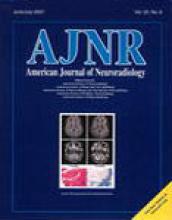Abstract
BACKGROUND AND PURPOSE: The lens of the eye is sensitive to radiation. Children undergoing CT of the head and patients undergoing repeated CT scanning of the head are vulnerable to this complication. The purpose of this study was to test the ability of a heavy metal, bismuth, in reducing radiation to the lens of the eye during routine cranial CT.
METHODS: Both phantom and human studies were done. Using a standard head-attenuating phantom, scanning was performed with detectors placed over the eye, first without the protectors, and then with shielding by one (1T), two (2T), or three thickness (3T) of bismuth-coated latex. The patient study included 30 patients randomized into one of three groups with eye protection provided by 1T, 2T, or 3T of the bismuth-coated latex. Control measurements were done using thermoluminescent dosimeters over the forehead above each eye. Image artifact from the bismuth shields was assessed.
RESULTS: The phantom study demonstrated that the use of bismuth-coated shielding over the eyes decreased radiation dosage by 48.5%, 59.8%, and 65.4% using 1T, 2T, and 3T, respectively. The effect of eye shielding in decreasing radiation dosage to the eye was highly significant for all three thicknesses (P = 2.9 × 10−81 to 1.9 × 10−89). In the patient study, the use of 1T, 2T, and 3T of bismuth-coated latex saved an average radiation dose of 39.6%, 43.5%, and 52.8%, respectively. While the use of shielding was statistically significant in saving radiation for all thicknesses (P = 2.2 × 10−10 to 1.4 × 10−21), there was no statistical difference between 1T, 2T, and 3T of bismuth-coated latex shielding found in patients. However, the trend was for increased radiation savings to the eye with increased thickness of shielding used. A review of all 30 studies showed no significant artifact caused by the eye shielding, regardless of thickness.
CONCLUSION: Bismuth-coated latex shielding of the eye during cranial CT is simple to apply, inexpensive, and causes up to a 50% reduction in radiation to the lens of the eye.
- Copyright © American Society of Neuroradiology












